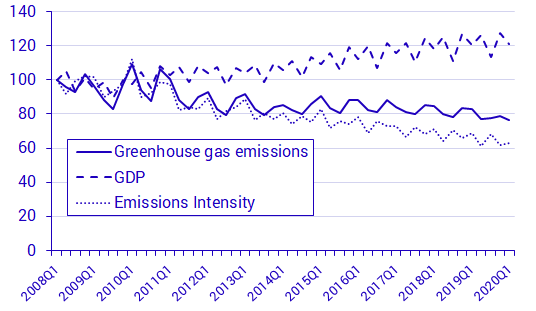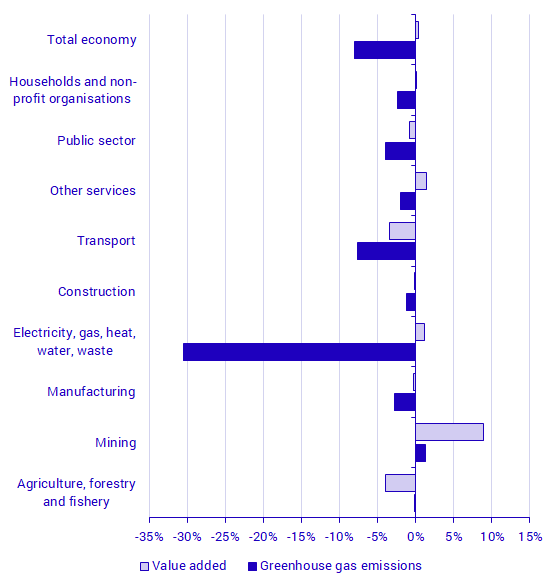Environmental Accounts – Emissions to air Q1 2020
Greenhouse gas emissions in Sweden’s economy decreased in the first quarter of 2020
Statistical news from Statistics Sweden 2020-09-01 9.30
Greenhouse gas emissions in Sweden’s economy decreased by 8.1 percent in the first quarter of 2020 compared with the same quarter in 2019. This decrease is mainly due to a decrease in emissions from the energy and transport sectors and manufacturing.
Greenhouse gas emissions from the Swedish economy amounted to 13.4 million tonnes of carbon dioxide equivalent in the first quarter of 2020. This is a decrease of 8.1 percent compared with the same period in 2019. Sweden’s GDP remained relatively unchanged in the same interval, with an increase of only 0.4 percent. The trend towards decreased greenhouse gas emissions per Swedish krona of economic production continued over this interval.

Source: Statistics Sweden
Emissions statistics are produced later than quarterly GDP statistics. Therefore, GDP and greenhouse gas emissions are compared only up to the first quarter of 2020. GDP for the second quarter of 2020 (published on 28 August) shows a decrease of 7.3 percent.
Emissions from the energy sector decreased
Greenhouse gas emissions decreased in most sectors in the first quarter of 2020 compared with the same period in 2019. The largest decrease occurred in the electricity, gas and heat sector, in which greenhouse gas emissions were 31 percent lower in the first quarter of 2020. This reduction is because of a substitution of fossil fuels, such as coal, heating oil and natural (fossil) gas, with biofuels. In addition, the 2019-2020 winter was mild. Tax rates for fossil fuel use in combined heat and power plants were also changed in the first quarter of 2020 compared to the same period in 2019.
Greenhouse gas emissions from the transport industry decreased by 8 percent in the first quarter of 2020 compared with the same period in 2019. There were reductions in greenhouse gas emissions by maritime transport and aviation. At the same time, value added in this sector decreased by 3 percent.
Greenhouse gas emissions from the manufacturing industry decreased by 3 percent in the first quarter of 2020 compared with the same period in 2019. Emissions decreased mainly in steel and other metal production. Value added in this sector remained relatively unchanged over the same interval.

Source: Statistics Sweden
| NACE 2007 industry | Greenhouse gas emissions | Value Added | |||||
|---|---|---|---|---|---|---|---|
| 2020Q1 | Change compared to same quarter 2019 | 2020Q1 | Change compared to same quarter 2019 | ||||
| Agriculture, forestry and fishery | 2 144 | ‑4 | ‑0,2% | 19 551 | ‑817 | ‑4,0% | |
| Mining | 276 | 3 | 1,3% | 11 571 | 949 | 8,9% | |
| Manufacturing | 3 681 | ‑105 | ‑2,8% | 173 517 | ‑601 | ‑0,3% | |
| Electricity, gas, heat, water, waste | 1 861 | ‑818 | ‑30,5% | 37 973 | 442 | 1,2% | |
| Construction | 418 | ‑5 | ‑1,2% | 74 151 | ‑43 | ‑0,1% | |
| Transport | 2 131 | ‑178 | ‑7,7% | 39 582 | ‑1 416 | ‑3,5% | |
| Other services | 789 | ‑16 | ‑2,0% | 506 260 | 6 907 | 1,4% | |
| Public sector | 144 | ‑6 | ‑4,0% | 240 237 | ‑2 009 | ‑0,8% | |
| Households and non-profit institutions [1] | 1 928 | ‑46 | ‑2,4% | 13 641 | 7 | 0,1% | |
| Total economy | 13 371 | ‑1 175 | ‑8,1% | 1 245 742 | 4 713 | 0,4% | |
[1] Only non-profit institutions provide value added. Source: Statistics Sweden
Revisions
For the reference periods first quarter 2008 up to and including the fourth quarter 2017, the statistics produced here used the monthly fuel, gas and inventory statistics as a source in calculating quarterly emissions from transport vehicles. For reference periods starting with and including first quarter 2018, other sources have been used. These sources included the register of reports to the Swedish Energy Agency in accordance with Sweden’s implementation of the EU’s Renewable Energy Directive (2009/28/EC) and other relevant physical data with short periodicity (more information is available in the Swedish quality declaration for the statistics here). The reason for this methodological development is that the monthly fuel, gas and inventory statistics have been deemed to be associated with significant uncertainties from the start of reference year 2018. These uncertainties are considered to have arisen due to a revision of the data collection survey used for the monthly fuel, gas and inventory statistics that was implemented at the start of 2018.
In accordance with this development, the following sources have been used to calculate emissions from transport vehicles for the first quarter of 2020:
- For maritime transport: The quarterly development of the number of vessels docking in Swedish ports (in gross tonnage) between the years, according to Sweden’s official statistics on shipping goods (from Transport Analysis, Trafikanalys)
- For aviation: The quarterly development of the number of landings at Swedish airports (from the Swedish Transport Agency, Transportstyrelsen)
- For heavy goods (road) vehicles: The quarterly development of transport work (in tonne-km) according to Sweden’s official statistics on road goods transport (from Transport Analysis, Trafikanalys)
- For passenger cars: The development of weekly changes in traffic volume on the state road network (from the Swedish Transport Administration, Trafikverket)
Emissions from mobile sources amount to almost 45 percent of the total, which should be taken into account when interpreting the data presented. This is particularly relevant for the period from the first quarter of 2019 in the transport sector, public sector, construction, other services and households. The total decrease in greenhouse gas emissions from mobile sources is about 4 percent for the first quarter of 2020 compared with the same period in 2019.
Several activities are underway to improve the statistics to make it possible to return to earlier methods.
Definitions and explanations
The System of Environmental Economic Accounting (SEEA) is constructed using the national accounts as a foundation and presents environmental and economic statistics in a common system. The SEEA makes it possible to analyse interactions between the economy and the environment. The starting point is Swedish economic actors’ environmental pressures, irrespective of where in the world they occur.
A residence adjustment is therefore applied to adjust statistical sources with a territorial perspective used to produce these statistics to the national and environmental accounts’ economic perspective. The residence adjustment applies primarily to transport: heavy duty road transport (primarily within H49 land transport companies, but also other industries, such as construction), maritime transport (H50) and aviation (H51). The residence adjustment for heavy duty road transport is based on data on transport work (in tonne-km) for Swedish companies abroad and foreign companies in Sweden, with data from Transport Analysis (Trafikanalys). For maritime transport and aviation, the residence adjustment is based on data for Swedish companies’ expenditure on fuel from Statistics Sweden’s National Accounts database on intermediate use in the economy, PRIOR.
Emissions and sequestration due to land use (LULUCF) and carbon dioxide capture and storage (CCS) are not included in the statistics.
The statistics produced here use a production perspective. This means that emissions are allocated to the actor and sector that produces the emissions. Indirect emissions arising due to imports and other consumption are not included.
The statistics produced here are not used directly to measure emissions in relation to nationally and internationally agreed climate targets. Statistics with a territorial perspective are used for that purpose. More information about different perspectives for emissions accounting is available on the Swedish Environmental Protection Agency’s website (in Swedish):
Next publishing will be
The next statistical news, on quarterly emissions to air for the second quarter of 2020, is scheduled for publication on 2020-10-29 at 9:30.
Statistical Database
More information is available in the Statistical Database
Feel free to use the facts from this statistical news but remember to state Source: Statistics Sweden.
